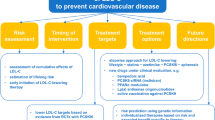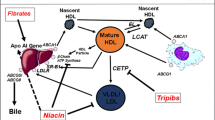Abstract
Increasing evidence suggests that the quality—rather than just the quantity—of low-density lipoproteins (LDLs) exerts a great influence on cardiovascular risk. LDLs comprise multiple subclasses with discrete size and density, and different physicochemical composition, metabolic behaviors, and atherogenicity. Individuals generally cluster into 2 broad subgroups. Most have a predominance of large LDLs, and some have a higher proportion of small particles. Small, dense LDLs are good predictors of cardiovascular events and progression of coronary artery disease. Their predominance has been accepted as an emerging cardiovascular risk factor by the National Cholesterol Education Program Adult Treatment Panel III. Several studies have shown that therapeutic modulation of LDL size and subclass is of great benefit in reducing the risk of cardiovascular events. This seems particularly true for statins and fibrates when they are administered to higher-risk patients, such as those with type 2 diabetes or vascular disease. Data reporting outcomes with the use of rosuvastatin, the latest statin molecule introduced to the market, and ezetimibe, a cholesterol absorption inhibitor, are promising.
Similar content being viewed by others

References
Krauss RM. Dietary and genetic probes of atherogenic dyslipidemia.Arterioscler Thromb Vasc Biol. 2005; 25: 2265–2272.
Berneis KK, Krauss RM. Metabolic origins and clinical significance of LDL heterogeneity.J Lipid Res. 2002; 43: 1363–1379.
Georgieva AM, van Greevenbroek MMJ, Krauss RM, et al. Subclasses of low-density lipoprotein and very low-density lipoprotein in familial combined hyperlipidemia: relationship to multiple lipoprotein phenotype.Arterioscler Thromb Vasc Biol. 2004; 24: 1–7.
Rizzo M, Berneis K. Should we measure routinely the LDL peak particle size?Int J Cardiol. 2006; 107: 147–151.
National Cholesterol Education Program (NCEP). Expert Panel on Detection, Evaluation, and Treatment of High Blood Cholesterol in Adults (Adult Treatment Panel III). Third Report of the National Cholesterol Education Program (NCEP) Expert Panel on Detection, Evaluation, and Treatment of High Blood Cholesterol in Adults (Adult Treatment Panel III) final report.Circulation. 2002; 106: 3143–3421.
Austin MA, Breslow JL, Hennekens CH, Buring JE, Willett WC, Krauss RM. Low-density lipoprotein subclass patterns and risk of myocardial infarction.JAMA. 1988; 260: 1917–1921.
Rizzo M, Berneis K. Low-density lipoprotein size and cardiovascular risk assessment.QJM. 2006; 99: 1–14.
Sacks FM, Campos H. Low-density lipoprotein size and cardiovascular disease: a reappraisal.J Clin Endocrinol Metab. 2003; 88: 4525–4532.
Rizzo M, Berneis K. The clinical relevance of low-density lipoproteins size modulation by statins.Cardiovasc Drugs Ther. 2006; 20: 205–217.
Gazi IF, Tsimihodimos V, Tselepis AD, Elisaf M, Mikhailidis DP. Clinical importance and therapeutic modulation of small dense low-density lipoprotein particles.Expert Opin Biol Ther. 2007; 7: 53–72.
Rosenson RS, Otvos JD, Freedman DS. Relations of lipoprotein subclass levels and low-density lipoprotein size to progression of coronary artery disease in the Pravastatin Limitation of Atherosclerosis in the Coronary Arteries (PLAC-I) trial.Am J Cardiol. 2002; 90: 89–94.
Otvos JD, Shalaurova I, Freedman DS, Rosenson RS. Effects of pravastatin treatment on lipoprotein subclass profiles and particle size in the PLAC-I trial.Atherosclerosis. 2002; 160: 41–48.
Rizzo M, Barbagallo CM, Pernice V, et al. Effects “beyond-cholesterol” of statins: simvastatin reduces the levels of atherogenic lipoproteins in patients with premature coronary artery disease.Nutr Metab Cardiovasc Dis. 2002; 12: 239.
Kontopoulos AG, Athyros VG, Papageorgiou AA, Hatzikonstandinou HA, Mayroudi MC, Boudoulas H. Effects of simvastatin and ciprofibrate alone and in combination on lipid profile, plasma fibrinogen and low density lipoprotein particle structure and distribution in patients with familial combined hyperlipidaemia and coronary artery disease.Coron Artery Dis. 1996; 7: 843–850.
Kazama H, Usui S, Okazaki M, Hosoi T, Ito H, Orimo H. Effects of bezafibrate and pravastatin on remnant-like lipoprotein particles and lipoprotein subclasses in type 2 diabetes.Diabetes Res Clin Pract. 2003; 59: 181–189.
Bays HE, McGovern ME. Once-daily niacin extended release/lovastatin combination tablet has more favorable effects on lipoprotein particle size and subclass distribution than atorvastatin and simvastatin.Prev Cardiol. 2003; 6: 179–188.
Winkler K, Abletshauser C, Hoffmann MM, et al. Effect of fluvastatin slow-release on low density lipoprotein (LDL) subfractions in patients with type 2 diabetes mellitus: baseline LDL profile determines specific mode of action.J Clin Endocrinol Metab. 2002; 87: 5485–5490.
Freed MI, Ratner R, Marcovina SM, et al, for the Rosiglitazone Study 108 Investigators. Effects of rosiglitazone alone and in combination with atorvastatin on the metabolic abnormalities in type 2 diabetes mellitus.Am J Cardiol. 2002; 90: 947–952.
Pontrelli L, Parris W, Adeli K, Cheung RC. Atorvastatin treatment beneficially alters the lipoprotein profile and increases low-density lipoprotein particle diameter in patients with combined dyslipidemia and impaired fasting glucose/type 2 diabetes.Metabolism. 2002; 51: 334–342.
Wägner AM, Jorba O, Bonet R, Ordóñez-Llanos J, Pérez A. Efficacy of atorvastatin and gemfibrozil, alone and in low dose combination, in the treatment of diabetic dyslipidemia.J Clin Endocrinol Metab. 2003; 88: 3212–3217.
Ikejiri A, Hirano T, Murayama S, et al. Effects of atorvastatin on triglyceride-rich lipoproteins, low-density lipoprotein subclass, and C-reactive protein in hemodialysis patients.Metabolism. 2004; 53: 1113–1117.
Frost RJ, Otto C, Geiss HC, Schwandt P, Parhofer KG. Effects of atorvastatin versus fenofibrate on lipoprotein profiles, low-density lipoprotein subfraction distribution, and hemorheologic parameters in type 2 diabetes mellitus with mixed hyperlipoproteinemia.Am J Cardiol. 2001; 87: 44–48.
Soedamah-Muthu SS, Colhoun HM, Thomason MJ, et al, for the CARDS Investigators. The effect of atorvastatin on serum lipids, lipoproteins and NMR spectroscopy defined lipoprotein subclasses in type 2 diabetic patients with ischaemic heart disease.Atherosclerosis. 2003; 167: 243–255.
Caslake MJ, Stewart G, Day SP, et al. Phenotype-dependent and -independent actions of rosuvastatin on atherogenic lipoprotein subfractions in hyperlipidaemia.Atherosclerosis. 2003; 171: 245–253.
Lahdenpera S, Tilly-Kiesi M, Vuorinen-Markkola H, Kuusi T, Taskinen MR. Effects of gemfibrozil on low-density lipoprotein particle size, density distribution, and composition in patients with type II diabetes.Diabetes Care. 1993; 16: 584–592.
O’Neal DN, O’Brien RC, Timmins KL, et al. Gemfibrozil treatment increases low-density lipoprotein particle size in type 2 diabetes mellitus but does not alter in vitro oxidizability.Diabet Med. 1998; 15: 870–877.
Superko HR, Berneis KK, Williams PT, Rizzo M, Wood PD. Gemfibrozil reduces small lowdensity lipoprotein more in normolipemic subjects classified as low-density lipoprotein pattern B compared with pattern A.Am J Cardiol. 2005; 96: 1266–1272.
Otvos JD, Collins D, Freedman DS, et al. Low-density lipoprotein and high-density lipoprotein particle subclasses predict coronary events and are favorably changed by gemfibrozil therapy in the Veterans Affairs High-Density Lipoprotein Intervention Trial.Circulation. 2006; 113: 1556–1563.
Kondo A, Morita H, Nakamura H, et al. Influence of fibrate treatment on malondialdehydemodified LDL concentration.Clin Chim Acta. 2004; 339: 97–103.
Hayashi K, Kurushima H, Kuga Y, et al. Comparison of the effect of bezafibrate on improvement of atherogenic lipoproteins in Japanese familial combined hyperlipidemic patients with or without impaired glucose tolerance.Cardiovasc Drugs Ther. 1998; 12: 3–12.
Ruotolo G, Ericsson CG, Tettamanti C, et al. Treatment effects on serum lipoprotein lipids, apolipoproteins and low density lipoprotein particle size and relationships of lipoprotein variables to progression of coronary artery disease in the Bezafibrate Coronary Atherosclerosis Intervention Trial (BECAIT).J Am Coll Cardiol. 1998; 32: 1648–1656.
Ayaori M, Momiyama Y, Fayad ZA, et al. Effect of bezafibrate therapy on atherosclerotic aortic plaques detected by MRI in dyslipidemic patients with hypertriglyceridemia.Atherosclerosis. 2006 Dec 29; [Epub ahead of print].
Feher MD, Caslake M, Foxton J, Cox A, Packard CJ. Atherogenic lipoprotein phenotype in type 2 diabetes: reversal with micronised fenofibrate.Diabetes Metab Res Rev. 1999; 15: 395–399.
Tan CE, Chew LS, Tai ES, et al. Benefits of micronised Fenofibrate in type 2 diabetes mellitus subjects with good glycemic control.Atherosclerosis. 2001; 154: 469–474.
Vakkilainen J, Steiner G, Ansquer JC, et al, for the DAIS Group. Relationships between lowdensity lipoprotein particle size, plasma lipoproteins, and progression of coronary artery disease: the Diabetes Atherosclerosis Intervention Study (DAIS).Circulation. 2003; 107: 1733–1737.
Al-Shaer MH. The effects of ezetimibe on the LDL-cholesterol particle number.Cardiovasc Drugs Ther. 2004; 18: 327–328.
Geiss HC, Otto C, Parhofer KG. Effect of ezetimibe on low-density lipoprotein subtype distribution: results of a placebo-controlled, double-blind trial in patients treated by regular low-density lipoprotein apheresis and statins.Metabolism. 2006; 55: 599–604.
Farnier M, Freeman MW, Macdonell G, et al, for the Ezetimibe Study Group. Efficacy and safety of the coadministration of ezetimibe with fenofibrate in patients with mixed hyperlipidaemia.Eur Heart J. 2005; 26: 897–905.
Grundy SM, Cleeman JI, Merz CNB, et al, for the Coordinating Committee of the National Cholesterol Education Program. Implications of recent clinical trials for the National Cholesterol Education Program Adult Treatment Panel III guidelines.Circulation. 2004; 110: 227–239.
Author information
Authors and Affiliations
Corresponding author
Rights and permissions
About this article
Cite this article
Rizzo, M., Rini, G.B. & Berneis, K. Effects of statins, fibrates, rosuvastatin, and ezetimibe beyond cholesterol: The modulation of LDL size and subclasses in high-risk patients. Adv Therapy 24, 575–582 (2007). https://doi.org/10.1007/BF02848780
Issue Date:
DOI: https://doi.org/10.1007/BF02848780



